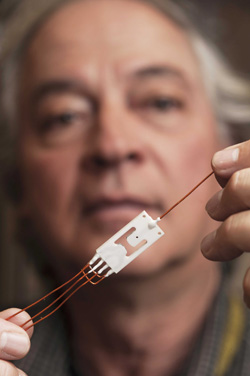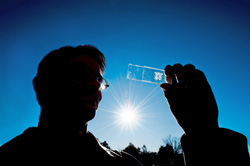ALBUQUERQUE, N.M. — Sandia National Laboratories researchers — competing in an international pool of universities, corporations and government labs — captured four prestigious R&D 100 Awards in this year’s contest.
R&D Magazine presents the awards each year to researchers whom its editors and independent judging panels determine have developed the year’s 100 most outstanding advances in applied technologies. An awards banquet will be held Nov. 1 in Orlando, Fla.
The awards, with their focus on practical impact rather than pure research, reward entrants on their products’ design, development, testing and production. The Chicago Tribune once described the contest as “the Oscars of invention.”
“Congratulations to this year’s R&D 100 award winners,” said Energy Secretary Steven Chu. “The research and development at the Department of Energy’s laboratories continues to help the nation meet our energy challenges, strengthen our national security and improve our economic competitiveness.”
Researchers at DOE labs received 36 awards. Sandia’s sister defense labs in the National Nuclear Security Administration, Los Alamos and Lawrence Livermore national laboratories, won three and four awards, respectively.
Sandia’s four winners are:
- Computer Chip Configuration for Neutron Generators The ultra-compact neutron generator, dubbed a “neutristor,” is a thousand times smaller than anything on the market today. A three-year Laboratory Directed Research and Development (LDRD) project led by Sandia researcher Juan Elizondo-Decanini turned away from conventional cylindrical tubes and demonstrated the basic technology necessary for a tiny, mass-produced neutron generator that can be adapted to medical and industrial applications. “The idea of a computer chip-shaped neutron source — compact, simple and inexpensive to mass-produce — opens the door for a host of applications,” Elizondo-Decanini said. Mounting the package on a computer chip allows varying numbers of layers in a stack, and the layers can be rotated for radial discharge to ramp up output. Elizondo-Decanini’s vision for the neutron generator of the future is one that uses no tritium and no vacuum and is made in a solid-state package. The technology is ready to be licensed for some commercial applications, but more complex commercial applications could take five to 10 years.
- The “Sandia Cooler,” also known as the “Air Bearing Heat Exchanger” will significantly reduce the energy needed to cool the processor chips in data centers and large-scale computing environments, said Sandia researcher Jeff Koplow. With the Sandia Cooler, heat from a conventional CPU cooler is efficiently transferred across a narrow air gap from a stationary base to a rotating structure. The normally stagnant boundary layer of air enveloping the cooling fins is subjected to a powerful centrifugal pumping effect, causing the boundary layer thickness to be reduced to ten times thinner than normal. The Sandia Cooler also offers benefits in other applications where thermal management and energy efficiency are important, particularly heating, ventilation and air-conditioning (HVAC).
- Microsystems Enabled Photovoltaics (MEPV) Sandia’s microsystems enabled photovoltaics, also known as “solar glitter,” combine mature technology and tools currently used in microsystem production with groundbreaking advances in photovoltaic cell design. The cells are created using mature microdesign and microfabrication techniques, said Sandia researcher Vipin Gupta. (Sandia researcher Greg Nielson led the project.) The cells are then released into a solution similar to printing ink and ‘printed’ onto a low-cost substrate with embedded contacts and microlenses for focusing sunlight onto the cells. Each cell can be as small as 14 microns thick and 250 microns wide, reducing material costs while enhancing cell performance by improving carrier collection and potentially achieving higher open circuit voltages. The technology has potential applications in buildings, houses, clothing, portable electronics, vehicles, and other contoured structures. Find more on Sandia’s MEPV work here.
- Preparation of Nucleic Acid Libraries for Ultra-High-Throughput Sequencing with a Digital Microfluidic Hub builds from Sandia’s RapTOR (Rapid Threat Organism Recognition) Grand Challenge. RapTOR rapidly identifies and characterizes unknown pathogens. It is a digital microfluidics “Grand Central Station” that manages and routes samples. “We’re taking advantage of DNA sequencing technology,” said Sandia’s Kamlesh (Ken) Patel. “Reading the genetic code, the original building blocks, allows you to begin characterizing a pathogen at the most basic level.” Patel leads the Automated Molecular Biology (AMB) research to scale down and automate traditional sample preparation methods such as normalization, ligation, digestion and size-based separation — methods that traditionally require a skilled scientist and take days or even weeks. The hub functions like a train station for samples, shrinking and enlarging samples as necessary and manipulating their speeds. Samples are cargoed within a microliter-scale droplet that is spatially moved across the Teflon-coated surface of the hub when electrostatic forces are appropriately applied. The hub moves samples from one step to the next with the flexibility to skip or repeat steps on the fly. The hub also manages the size of the sample, extracting the right amount for each process.



